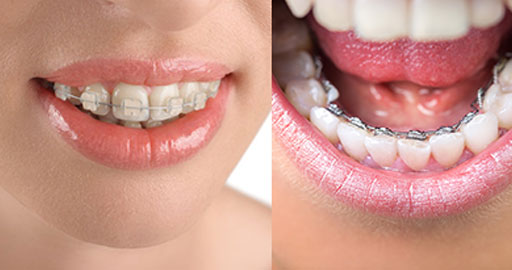
What are the types of braces?
When it comes to orthodontic treatment, three main types of braces stand out: braces metal, ceramic braces, and lingual braces. Each of these options has its unique features, advantages, and considerations. Let’s delve into the details of these three popular choices to help you make an informed decision on your journey to a beautiful smile.
Traditional Metal Braces
Metal braces are the classic choice for orthodontic treatment. They’ve been around for decades and have successfully straightened countless smiles. Here’s what you need to know about them:
Components:
- Brackets: These are the small metal squares that are bonded to each tooth with special adhesive.
- Archwires: These are the thin wires that run through the brackets and apply gentle pressure to guide your teeth into the desired positions.
- Elastic Bands: These bands connect the brackets and help with various tooth movements.
Pros:
- Effectiveness: Metal braces are highly effective in treating complex dental issues, including severe misalignments.
- Durability: They are sturdy and can withstand daily wear and tear.
- Cost-Effective: Generally, metal braces are more affordable than some of the alternative options.
Cons:
- Visibility: Metal braces are noticeable, which can affect your appearance during treatment.
- Oral Hygiene: Proper cleaning can be a bit challenging due to the many components, but dental professionals can provide guidance.
Ceramic Braces
Ceramic braces offer a more subtle alternative to their metal counterparts. They are often preferred by those who want effective treatment with less visibility:
Components:
- Tooth-Colored Brackets: Instead of metal, ceramic braces use brackets that are either clear or tooth-colored.
- Archwires: Like metal braces, ceramic braces employ archwires to move the teeth.
Pros:
- Aesthetics: Ceramic braces blend in with your natural teeth, making them less noticeable.
- Effectiveness: They are still highly effective, especially for moderate dental issues.
- Comfort: Ceramic braces are generally more comfortable than metal braces.
Cons:
- Durability: Ceramic brackets are more prone to chipping or staining compared to metal brackets.
- Cost: They tend to be slightly more expensive than traditional metal braces.
Lingual Braces
For those who prioritize discretion above all else, lingual braces are a hidden gem in the world of orthodontics:
Components:
- Customized Brackets: Lingual braces are attached to the back (lingual) surface of your teeth, making them virtually invisible.
- Archwires: Similar to traditional braces, lingual braces use wires to guide tooth movement.
Pros:
- Invisibility: Lingual braces are completely hidden from view when you smile, providing the ultimate aesthetic advantage.
- Effectiveness: They are as effective as traditional braces, addressing a wide range of orthodontic issues.
- Customization: Lingual braces are custom-made for each patient, ensuring a precise fit.
Cons:
- Discomfort: Lingual braces can take some time to get used to, as they may interfere with tongue movement and speech initially.
- Cost: They are often the most expensive option due to their customization and complexity.
In the end, the choice between metal, ceramic, and lingual braces boils down to your personal preferences, budget, and orthodontic needs. Consult with your orthodontist at a dental clinic near you, who will assess your individual case and help you select the braces that will pave the way to your perfect smile.
Remember, no matter which option you choose, the result will be a confident, beautiful grin that you’ll proudly show off for years to come.
Leave a Reply
Leave a Reply
Explore More Similar Posts
Explore More Blogs


Leave a Reply